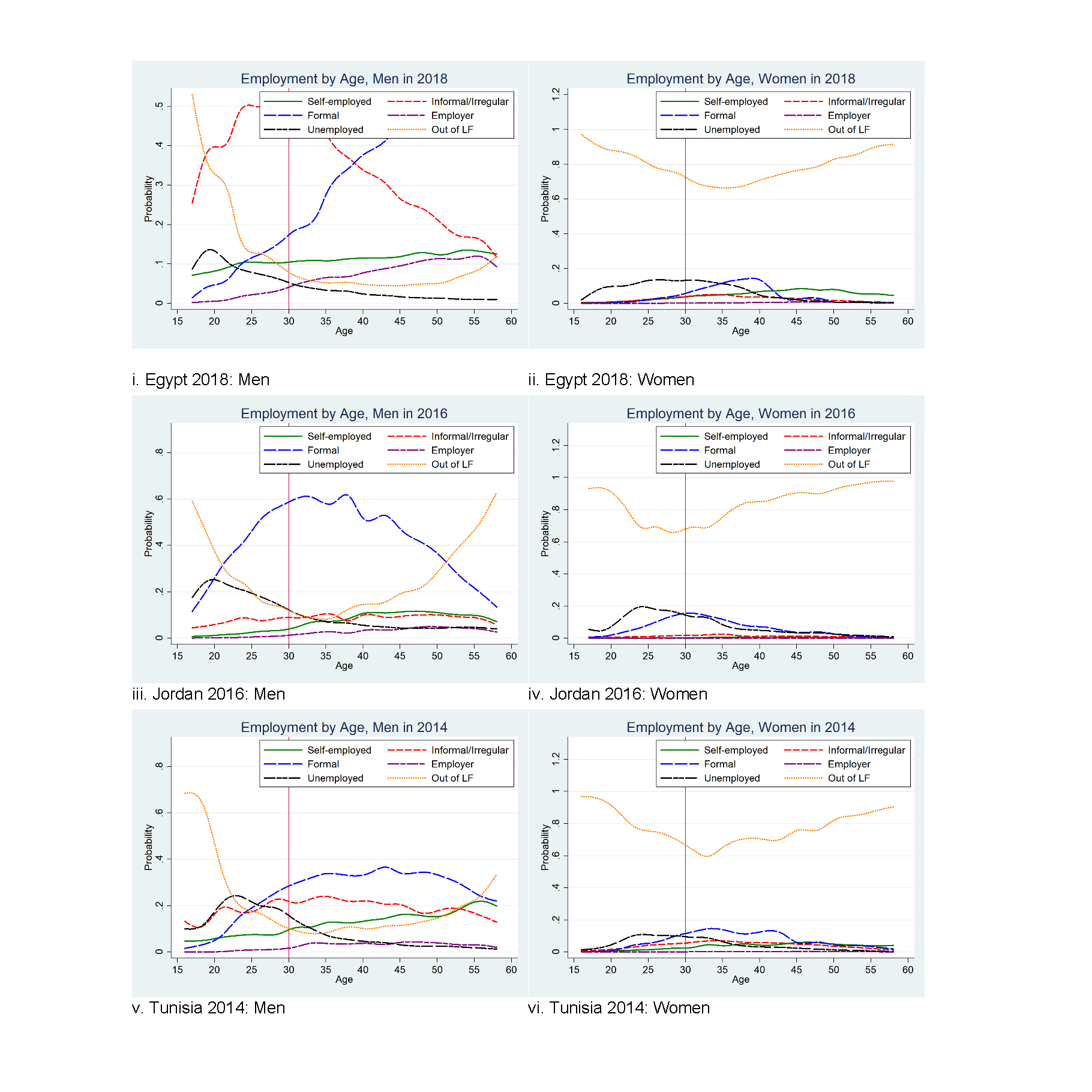Blog
Precarious employment for youth in Egypt, Jordan, and Tunisia
Youth (those aged 15–29) in the Middle East and North Africa (MENA) face notoriously precarious employment prospects. Youth unemployment is the highest in the world — currently 23% in Arab States and 30% in Northern Africa in 2019, and nondecreasing.1 Unemployment among young women in the region is near double that for young men, reaching 42%, and has been growing at a faster rate. More alarming still is that even when employed, youth tend to work in vulnerable and informal jobs which lack job security and stability, paid leave, social and health insurance, and occupational safety.
In-depth analysis of three MENA countries over several years for which we have panel and retrospective data reveals similarities across nations, but also a few important differences. Youth in all three countries were disadvantaged compared to older workers in terms of employment status. Most youths land in vulnerable positions, defined as self-employment, unpaid family work, irregular wage work, or informal private sector work. These workers share unfavourable working conditions — such as low job security, and a lack of contracts, benefits, and any form of social protection.
Over time, the share of youth in vulnerable employment increased steadily in Egypt, from 18% in 1998 to 30% in 2018. In Jordan, by contrast, youth employment vulnerability fell from 13% in 2010 to 9% in 2016, but the share of youth who were either unemployed or out of the labour force and ‘Not in Education, Employment, or Training (NEET)’ rose. The Tunisian experience has been somewhere in-between, with 18% of the workforce in vulnerable employment as of 2014. Youth in these countries were also two to three times more likely to be ‘low-earners’ and among the ‘working poor’ when compared to benchmark national poverty lines for each country.
Social status, youth employment prospects, and ‘dead-end’ jobs
Dynamic analysis confirms that youth who start out in vulnerable positions have a hard time transitioning to decent jobs later. Some even move ‘down’ to informal jobs. Having lower family wealth and having less-educated fathers are very strong determinants of vulnerable employment among youth.
These associations between family circumstances and employment outcomes persist even years later —20 years in the case of Egypt. Similar patterns persist in Jordan and Tunisia in terms of family wealth. In Egypt and Jordan, fathers’ education is also associated with a higher propensity of persistent vulnerable employment, even many years after youth first enter the labour market. The impact was different in Tunisia, where the children of the least-educated fathers are more likely to be unemployed or to remain inactive, while children of university graduates, when employed, are almost exclusively in formal jobs.
Further analysis confirms that youth workers are less likely to obtain good jobs than older workers. Contrary to other world regions, college graduates in all three countries had a high probability of remaining unemployed, presumably hoping to land formal private or public sector employment. While workers can rely on consistent returns to education through prospects for better employment, substantial differences in these returns exist between males and females. Female workers are most likely to remain out of the labour force for long periods during their prime working age.
Figure 1: Predicted probability of employment type by age and gender

Lifelong employment prospects
Figure 1 illustrates how employment prospects are estimated to evolve over a worker’s lifetime. Among Egyptian men, the predominant risk is of holding informal or irregular employment, and only in the mid-30s starting to transition into formal employment, self-employment, or a status as an employer. The chance of formal employment overtakes the chance of informal employment only at the age of 40. The situation in Jordan and Tunisia is somewhat rosier, with formal employment being the most likely status among male workers by their mid-20s. However, even in Jordan and Tunisia informal employment is rather prevalent and chronic, with the probability exceeding 10% in Jordan and 20% in Tunisia through much of men’s working lives.
For women across all three countries, the predominant fate is to remain out of the labour force throughout their working age. The probability of becoming active in the labour force never exceeds 25% in any of the three countries. Despite women’s intensive search for employment upon their graduation and into their 30s, it is only between the ages of 30–40 that their chance of attaining formal employment increases slightly to 15–20%. Finally, worth noting, the prospect of being self-employed rises among Egyptian women in their 30s and 40s, and self-employment becomes the leading status among economically active women in their early 40s and older.
Deepening inequalities and policy solutions
Evidence from the ground suggests that the precariousness of jobs, and the employment gaps by age, gender, and family socioeconomic status, are becoming ever more aggravated over time. The COVID-19 pandemic has further worsened prospects for the most vulnerable groups, including youth, women, and non-citizen residents.
These findings suggest that policy makers need to move beyond efforts to reduce the high unemployment rate of youth in the region, to creating more decent jobs and facilitating career transitions for youth workers. This is both a supply- and demand-side problem that needs dedicated efforts to both raise the skill levels and employability of workers and create conditions for firms to offer more formal job opportunities for youth.
On the supply side, effort to formalize will require active labour market policies that provide demand-driven training and internship opportunities for workers to endow them with the necessary skills for a fast-changing labour market. On the demand side, it will require regulatory changes that provide incentives for firms to formalize, such as tax breaks, preferential access to financing, and where feasible direct subsidies for formal hiring of the most vulnerable groups, youth and women, since even formal businesses often hire workers informally to avoid high formalization costs. Such a two-pronged effort will help reduce inefficiency, raise productivity and create a more inclusive growth environment.
 Join the network
Join the network





